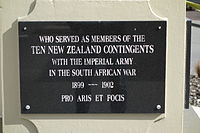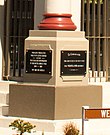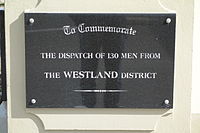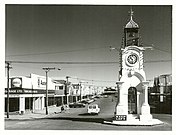Hokitika Clock Tower
| Hokitika Clock Tower | |
|---|---|
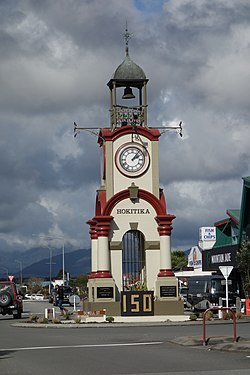 The Hokitika Clock Tower in 2015 with a "150" sign commemorating the sesquicentennial of Westland the previous year[1] | |
| Location | Hokitika, New Zealand |
| Coordinates | 42°43′05.5″S 170°57′49.5″E / 42.718194°S 170.963750°E |
| Built | 1902–1903 |
| Built for | Queen Victoria's Diamond Jubilee |
| Architect | William Parkinson |
| Governing body | Westland District Council |
| Official name | Memorial Clock Tower |
| Designated | 21 September 1989 |
| Reference no. | 5054 |
The Hokitika Clock Tower, initially called the Westland War Memorial and then the Coronation and War Memorial, is a prominent landmark in Hokitika, New Zealand. The memorial was initiated, fundraised for, and carried out by a committee, to commemorate the region's contribution to the Second Boer War; not just the four local men who had died but all 130 who had gone to war in South Africa. An additional purpose was to provide Hokitika with a town clock.
The driving force behind the initiative was Henry Michel, the mayor of Hokitika at the time. After fundraising had begun, the upcoming coronation of Edward VII was announced and the tower was designated to also commemorate that occasion. Former resident of Hokitika and then premier of the country, Richard Seddon, lent his support, laid the foundation stone, and gave the main speech at the memorial's unveiling, some 17 months later in June 1903. Seddon's wife was a significant fundraiser in Wellington for the project, raising 7% of the cost, and was asked to unveil the tower. The work was undertaken by a stonemason in Auckland specialising in monumental sculpture, with the components all produced in their Auckland workshop and then shipped down for assembly on site. The four-faced town clock was ordered from England and installed by another Aucklander.
The memorial is within a roundabout on the main road into Hokitika and is practically unchanged, apart from the square iron fence that initially surrounded the tower having been replaced by a much larger circular concrete kerb. Since 1989, the tower has been on the national heritage register.
History
[edit]Hokitika is located on the West Coast of New Zealand's South Island. Former Hokitika resident, New Zealand premier, and representative of the local Westland electorate, Richard Seddon, agreed for troops to be sent to South Africa in September 1899. This was in support of Britain in their escalating conflict with the South African Republic. The Second Boer War broke out on 11 October 1899 and the Westland region would send 130 men to serve in South Africa, four of whom would be killed.[2]
A Peace Celebration Committee was formed in Hokitika in June 1900 and at their inaugural meeting, it was decided that a memorial should be erected, listing the names of all Westland men who went to war,[3] and to also commemorate the eventual peace.[4] The mayor of Hokitika Borough, Henry Michel, was the driving force behind the memorial.[5] In October 1901, it was decided to place the memorial in the middle of the intersection of Sewell and Weld streets, and to invite the premier to lay the foundation stone early in the coming year.[6] The selected site had previously been used for a memorial for four West Coast pioneers who drowned or were murdered in the 1860s: George Dobson, Charlton Howitt, Henry Whitcombe, and Charles Townsend.[7] This memorial had previously been relocated to Hokitika Cemetery.[8] The borough council granted the request for the site in late November 1901.[9] The following month, a public competition was held for a motto for the monument. The committee received 40 letters and the chosen motto was the Latin phrase Non sibi sed patriae meaning "Not for self, but for country". The chosen motto had been submitted by Miss Vida Perry and she won the one guinea (21 shilling) prize donated by the mayor.[10]
| Motto | Submitter | Committee rating |
|---|---|---|
| Non sibi sed patriae (Not for self, but for country) | Miss Vida Perry | prize taker |
| Dulce et decorum est pro patria mori (It is sweet and fitting to die for the homeland) | Lucy Michel, Hokitika | commended |
| Post cineres gloria venit (Glory comes after death) | F. H. Rickard, Hokitika | commended |
| Each life wove a strand in the crimson cord | R. W. Greenwood, Greymouth | commended |
On 28 December 1901, Seddon sent a telegraph that he was leaving for Greymouth later that day to spend a week on the West Coast, during which time the foundation stone could be laid. The committee responded that there was insufficient time to prepare and would prefer to wait until his next scheduled visit on 14 February 1902.[12]
In his role as mayor, Michel asked mayors of other West Coast boroughs to also declare Friday, 14 February 1902 a public holiday[13][14] and the mayors of the boroughs of Brunner, Ross, Greymouth, and Kumara did so.[15][16] When Seddon arrived in Hokitika, his first official action was to drive the first pile for the railway bridge over the Hokitika River so that the railway could be extended south; what became known as the Ross Branch would reach Ross in 1909. Immediately afterwards, Seddon laid the foundation stone for what was then known as the Westland War Memorial. This was done as a full Masonic ceremony, with Seddon as Acting Grand Master representing the Grand Lodge of New Zealand. Both ceremonies were held in driving rain but there was a "very large attendance" by Westland people.[2][17] As was usual at the time, the funds for the memorial were fundraised, and Louisa Jane Seddon (the premier's wife) had raised NZ£70 from ex-West Coasters who were living in the country's capital, Wellington.[7][18]

It took more than a year to erect the monument. In the meantime, Edward VII had his coronation in August 1902 and it was decided to also designate the memorial in honour of this event.[2] It shares the dual function of a Boer War memorial and commemoration of Edward VII's coronation with memorials in Whanganui, Greymouth, Motueka, and Ashburton. The other New Zealand memorial that also commemorates peace, is in Marton.[4] The clock tower was unveiled on 3 June 1903 (the birthday of the Prince of Wales, George Frederick Ernest Albert), with perfect weather and a crowd of 5,000 onlookers; over 3,000 of them[19] arrived by train. The mayor of Hokitika Borough, Michel, spoke first, followed by the unveiling of the clock tower by Seddon's wife. Seddon himself then addressed the crowd with a long speech. Brief speeches were then given by Arthur Clifton (chairman of Westland County), Arthur Guinness (member of the House of Representatives for the Grey electorate), James Holmes (a Hokitika resident and member of the Legislative Council), and Major General James Babington (a Boer War veteran who at the time was the Commandant of the New Zealand Military Forces).[20][21]
On 21 September 1989, the Hokitika Clock Tower was registered by the New Zealand Historic Places Trust (since renamed Heritage New Zealand) as a Category II heritage structure with registration number 5054. It is a prominent landmark in the town.[2]
Construction and changes
[edit]The contract for the design and erection of the memorial was awarded to the stonemason William Parkinson of Auckland.[2] The company had previously produced the Trooper's Memorial[22] and the granite plinth for the Queen Victoria Statue,[23] both located in Auckland's Albert Park.[24] Although the foundation stone was laid in February 1902, it was not until July that year that the final design for the memorial was agreed on. The memorial was built in Auckland and then shipped to Hokitika for installation. A four-faced clock, manufactured by Gillett & Johnston in Croydon, England,[23] and installed by Alfred Bartlett[25] of Auckland, was to function as the town clock.[26] To combine the commemoration of a war memorial with the utility of providing a town clock is unusual in New Zealand.[27] There does not appear to have been any discussion about this dual-purpose in Hokitika. In contrast, the 1950s proposal to add a clock to the Invercargill Troopers' Memorial caused considerable controversy and was only agreed to as a practical means to getting the memorial renovated.[27]
The memorial has a square concrete base 3.4 metres (11 ft) wide and 0.91 metres (3 ft) high. The foundation supports four square bases; one for each corner. Two faces of each square face outwards, with these eight faces having a memorial tablet mounted on them. One of the tablets shows the chosen motto. The square bases support turned columns and turned caps. Above the four columns, arches with a keystone give a striking effect. The square tower above the arches holds the clock, with a circular stone surrounding each clock face. Moulded arches top the masonry part of the tower. A belfry is mounted on top, with iron columns, ironwork friezes, four chiming bells, topped by a copper cupola with a decorative iron finial.[23] Only four other Boer War memorials in New Zealand—Granity, Milton, Lawrence, and Featherston—have a cupola.[28] Except for the pillars, which are made of bluestone, the structure above the base is made of Mount Somers / Te Kiekie stone. To the top of the finial, the tower measures 11.4 metres (37 ft 6 in).[23]
The belfry had started to rust and was replaced in 1957. Initially, there was an iron chain rail at the square base of the footing. The iron chain rail was removed and the base slightly enlarged to form an octagon. A larger, circular ring was later added that supports the operation of the intersection as a roundabout. This concrete ring was later fitted with landscaping.[2]
Citations
[edit]- ^ "Greymouth Artists Revitalise CBD for 150th". Grey District. 6 May 2015. Retrieved 7 September 2020.
- ^ a b c d e f "Memorial Clock Tower". New Zealand Heritage List/Rārangi Kōrero. Heritage New Zealand. Retrieved 6 September 2020.
- ^ "Peace Celebration Committee". West Coast Times. No. 11620. 15 June 1900. p. 4. Retrieved 6 September 2020.
- ^ a b Maclean and Phillips 1990, p. 55.
- ^ "Grand Concert and Entertainment". West Coast Times. No. 11850. 16 March 1901. p. 3. Retrieved 6 September 2020.
- ^ "War Memorial Fund". West Coast Times. No. 12055. 31 October 1901. p. 3. Retrieved 6 September 2020.
- ^ a b "The War Memorial". West Coast Times. No. 12144. 15 February 1902. p. 3. Retrieved 6 September 2020.
- ^ "A Monument to George Dobson, Charlton Howitt, Henry Whitcombe and Charles Townsend, Hokitika". West Coast New Zealand History. Retrieved 6 September 2020.
- ^ "Hokitika Borough Council". West Coast Times. No. 12074. 23 November 1901. p. 3. Retrieved 6 September 2020.
- ^ "The War Memorial". West Coast Times. No. 12102. 27 December 1901. p. 3. Retrieved 7 September 2020.
- ^ "Westland War Memorial". West Coast Times. No. 12107. 3 January 1902. p. 4. Retrieved 7 September 2020.
- ^ "Untitled". West Coast Times. No. 12104. 30 December 1901. p. 2. Retrieved 7 September 2020.
- ^ "Are we to Advance?". West Coast Times. No. 12137. 7 February 1902. p. 2. Retrieved 7 September 2020.
- ^ "Borough of Hokitika". West Coast Times. No. 12141. 12 February 1902. p. 3. Retrieved 7 September 2020.
- ^ "Westland War Memorial: Laying the Foundation Stone". West Coast Times. No. 12139. 10 February 1902. p. 4. Retrieved 7 September 2020.
- ^ "Round about Kumara". West Coast Times. No. 12139. 10 February 1902. p. 4. Retrieved 7 September 2020.
- ^ "Mr Seddon at Hokitika". Greymouth Evening Star. Vol. XXXI, no. 12139. 15 February 1902. p. 3. Retrieved 6 September 2020.
- ^ "The War Memorial Fund". West Coast Times. No. 12048. 23 October 1901. p. 3. Retrieved 7 September 2020.
- ^ "Hokitika South African War Memorial". Ministry for Culture and Heritage. 20 December 2012. Retrieved 7 September 2020.
- ^ "Westland War & Coronation Memorial (p 2)". West Coast Times. No. 12519. 4 June 1903. p. 2. Retrieved 6 September 2020.
- ^ "Westland War & Coronation Memorial (p 3)". West Coast Times. No. 12519. 4 June 1903. p. 3. Retrieved 6 September 2020.
- ^ "South African War Artillery Memorial". New Zealand Heritage List/Rārangi Kōrero. Heritage New Zealand. Retrieved 7 September 2020.
- ^ a b c d "The War and Coronation Memorial". West Coast Times. No. 12508. 22 May 1903. p. 4. Retrieved 7 September 2020.
- ^ "Queen Victoria Statue". New Zealand Heritage List/Rārangi Kōrero. Heritage New Zealand. Retrieved 7 September 2020.
- ^ "Obituary". Auckland Star. Vol. XL, no. 45. 22 February 1909. p. 3. Retrieved 6 September 2020.
- ^ "The Coronation and War Memorial". West Coast Times. No. 12258. 2 July 1902. p. 4. Retrieved 6 September 2020.
- ^ a b Maclean and Phillips 1990, p. 63.
- ^ Maclean and Phillips 1990, p. 102.
General references
[edit]- Maclean, Chris; Phillips, Jock (1990). Willis, Debbie (ed.). The Sorrow and the Pride: New Zealand War Memorials. Wellington, N.Z.: Department of Internal Affairs, Historical Branch; GP Books. ISBN 9780477014755. OCLC 24219355.

